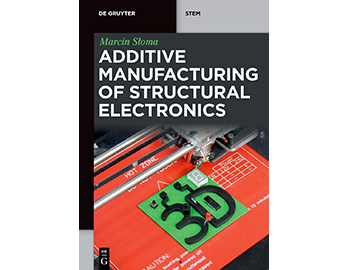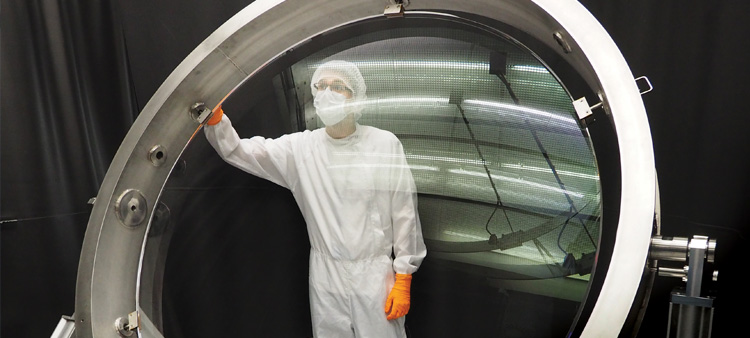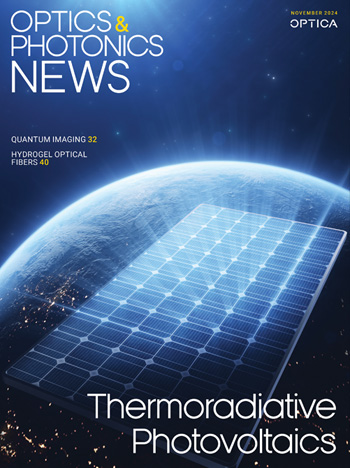
Thermoradiative Photovoltaics
Devices that operate like solar cells in reverse can generate power even in the absence of sunlight, offering an alternative route for energy production.
01 November 2024Enhancing Optical Microscopy with Quantum Entanglement
Drawing on the unique properties of entangled photons, quantum approaches can overcome the limitations of classical methods, enhance spatial resolution and reduce stray light and shot noise.
01 November 2024Hydrogel Optical Fibers
Researchers are working to coax a class of superbly biocompatible polymer–water hybrids into light-guiding channels for sensing, optogenetics and more.
01 November 2024A Career in Subsea: The Final (Fiber) Frontier
The Optical Fiber Communications Workshop, hosted by an Optica/SPIE Student Chapter, showcased career opportunities in the burgeoning field of subsea communications.
18 October 2024
Additive Manufacturing of Structural Electronics
A thoughtful reference covering many topics related to additive manufacturing.
17 October 2024Aurora Borealis
The aurora visible from southern Oregon, USA. The pole star Polaris can be seen just above the rays pointing toward it.
18 October 2024November 2024 Issue
LATEST NEWS
Hot Carriers Get Caught on Camera
An ultrafast imaging technique has captured the dynamics of energetic charge carriers at the interface between two semiconductors.
17 October 2024Ultra-Thin Laser Sets Power Record
A painstaking arrangement of mirrors and a device made from quantum wells yield strong, fleeting light pulses.
16 October 2024Reactivating Spatial Memories with Light
Researchers leverage an optically enabled gene-expression technique to cause mice to seek out shelter even when one isn’t present.
10 October 2024Photonics21 Study Spotlights Fusion Energy Markets
Report from European public–private partnership stresses the centrality of photonics as a fusion-enabling technology—regardless of the specific technical approach pursued.
10 October 2024Optical Tweezers on an Integrated Chip
New device uses an optical phased array to manipulate particles from a greater distance than in previous experiments.
09 October 2024ADVERTISEMENT
EDITOR'S PICKS

The Vera C. Rubin Observatory
A specially designed, ultrafast telescope and the world’s largest CCD camera could expand our understanding of the universe—if a fog of telecommunications satellites doesn’t spoil the view.
01 February 2024Real-World Focus at the Photon Factory
The ultrafast spectroscopy and micromachining lab at the University of Auckland connects fundamental science with industry applications.
01 May 2024James Clerk Maxwell’s Vampire
Introducing a lesser-known work of the great 19th-century scientist—a poem about a blood-sucking monster.
01 November 2022Axicon Light
A diffractive axicon under LED illumination produces a system of colorful rings that form nearly Bessel beams.
01 May 2023ADVERTISEMENT
Aurora Borealis
The aurora visible from southern Oregon, USA. The pole star "Polaris" can be seen just above the rays pointing towards it.
18 October 2024A Sustainable Future for Semiconductors
FUTUR-IC aims to use electronic–photonic integration to create high-performance microchip technology while minimizing environmental impact.
01 November 2024Looking Deeper into “Why?”
Anticipating questions and providing reasonable answers can significantly add to your credibility.
01 November 2024CAREERS
A Career in Subsea: The Final (Fiber) Frontier
The Optical Fiber Communications Workshop, hosted by an Optica/SPIE Student Chapter, showcased career opportunities in the burgeoning field of subsea communications.
18 October 2024Journeys in Optics: George Dwapanyin
Dwapanyin talks about his time as an Optica Ambassador, his involvement with Optica’s 2020 DEI Rapid Action Committee and the role community has had in his career.
15 October 2024Journeys in Optics: Jason Adams
Adams discusses the genesis of his career in optics, his previous career as an audio engineer and the role of travel in his work.
03 September 2024Celebrating the Legacy of the Siegman School
Considering the impact and future of Anthony Siegman’s namesake program on its 10th anniversary.
30 August 2024Journeys in Optics: Brandon Buscaino
Buscaino discusses his time as president of the Stanford Optical Society, his experience as an Optica Ambassador and why he chose a career in industry.
06 August 2024
